Day 2 of a long weekend of tours today. Having walked the Holkham end of the coastal pines yesterday, we headed to Wells Woods today. It was very dull and overcast first thing, and rather windy with a very blustery NE, but at least it was sheltered in the trees.
We decided to concentrate on the open areas to the south of the woods initially, where the light was better. There were lots of Blackbirds and thrushes in the brambles and hawthorns – Song Thrushes, Redwings and a few Fieldfares as well today. While the latter two are the classic winter thrushes, which come here from the continent, our resident Blackbird and Song Thrush population is also swelled with large numbers coming in from colder climes at this time of year. There were also a couple of Bullfinches lurking amongst the bushes – we could hear them calling, but typically shy they flew away ahead of us. A Lesser Redpoll flew over calling, but dropped down into the birches out of view, and several Bramblings were flying around over the trees.
 Fieldfare – there were lots of thrushes in the bushes first thing this morning
Fieldfare – there were lots of thrushes in the bushes first thing this morning
We worked our way west along the main track. There were flocks of tits to search through – Long-tailed, Blue, Great and Coal Tits – together with the odd Treecreeper… and masses of Goldcrests. Almost every tree seemed to have at least one Goldcrest in it today, all feeding feverishly. It made locating the rarities more complicated, with so many birds to sift through, but it was amazing to see them all.
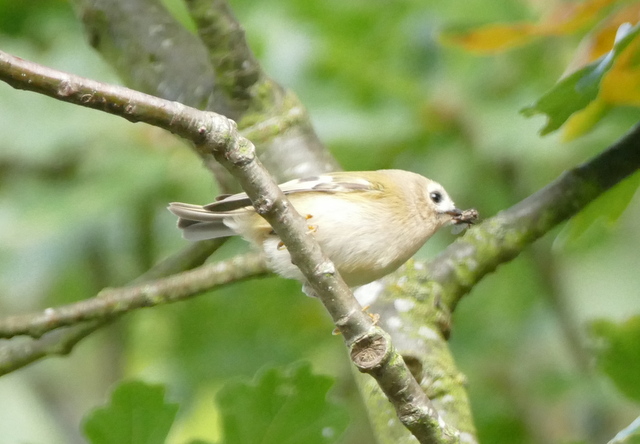 Goldcrest – there were masses in the pines again today
Goldcrest – there were masses in the pines again today
A Pallas’s Warbler had been reported with the tit flock west of the drinking pool. We had no problem finding a tit flock, but we didn’t know if it was the right one. The flocks can move quite quickly through the trees, with individual birds stopping to feed for a few seconds even when the flock as a whole seems to be constantly on the move. We spent some time following this flock, but we couldn’t see any lost Siberian warblers in amongst it. There were one or two Chiffchaffs in with all the other birds.
We were then pointed in the direction of another Pallas’s Warbler, further west still along the track. When we got to the spot, there was no sign of it at first. Thankfully, a friendly birder managed to locate it, feeding on its own in some small oaks deeper into the trees. We could see it fluttering around in the leaves, with a deep yellow supercilium and prominent double wing bar. However, it was hard to see the distinctive lemon yellow rump patch from below, or the crown stripe.
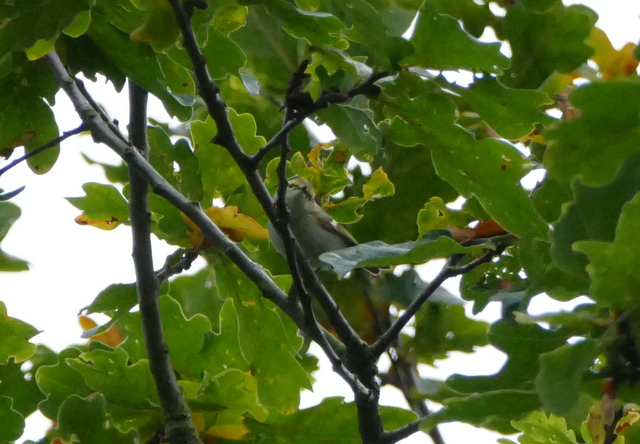 Pallas’s Warbler – feeding in the tops of some young oaks
Pallas’s Warbler – feeding in the tops of some young oaks
The Pallas’s Warbler suddenly flew from the oaks it had been in, to another taller tree further along where we could just see it, before it dropped out of the other side and disappeared again. Pallas’s Warblers are always a crowd pleaser. Almost as small as a Goldcrest and covered in bright yellow stripes, they flit and hover in among the leaves looking for insects. Breeding in southern Siberia, they should be on their way to winter in SE Asia or southern China. In some years, large numbers can be displaced westwards and turn up in western Europe. Having missed one last night, it was nice to catch up with a Pallas’s Warbler this morning.
There has also been a Hume’s Warbler along the path here, a little further towards Wells, and that was our next target. As we walked back along the path, we could see a large crowd gathered, but they had not seen any sign of it for a while. We walked into the trees, to try to refind it, but when we re-emerged onto the path, we could see the throng had moved a little further along. As soon as we joined them we could hear the Hume’s Warbler calling, and eventually we got some great views of it in the birch trees by the path. We followed it for a while, or followed the distinctive call as it moved rapidly up and down the line of trees, and saw it very well again when it paused for several minutes to feed in a low hawthorn.
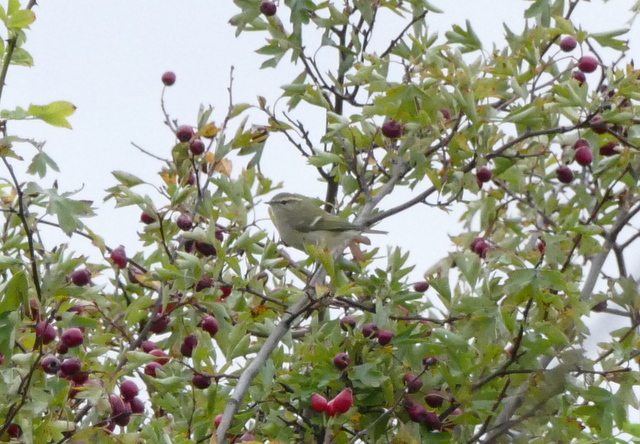 Hume’s Warbler – like a dull Yellow-browed Warbler, with a distinctive call
Hume’s Warbler – like a dull Yellow-browed Warbler, with a distinctive call
The Hume’s Warbler is another bird blown over from Siberia, on its way to wintering grounds in the Indian subcontinent or southern China. Until recently it was considered just a subspecies of Yellow-browed Warbler, but with markedly different vocalisations and some mostly consistent differences in appearance, it was elevated to a species in its own right. It is best identified by its call here – a deeper, more strongly disyllabic ‘tchuu-eet’ (compared to the thinner, higher ‘tsooeet’ call of Yellow-browed) – but it is also a duller, greyer species than its close relative.
With two Siberian warblers seen already, we made our way back to the drinking pool. A second Red-flanked Bluetail, a different bird to the one we had seen at the Holkham end of the pines recently, had been found at the drinking pool yesterday and was still present today. With so many rare birds in North Norfolk at the moment, there were unprecedented crowds at Wells Woods today, and once again we joined a large group waiting for the Bluetail to appear. It didn’t take long, flying out of the dense vegetation and up into the low bushes by the side of the pool.
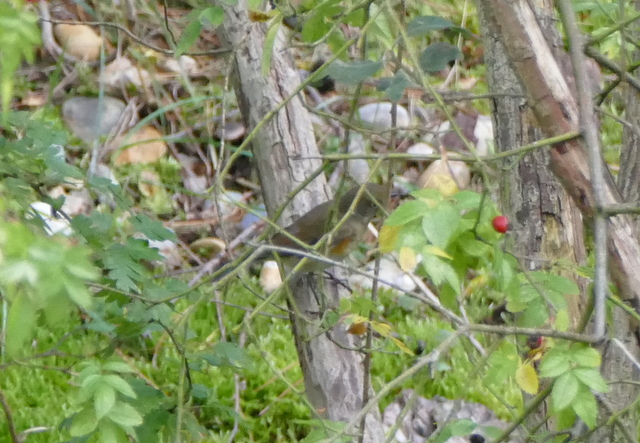 Red-flanked Bluetail – our second in two days, well hidden at first
Red-flanked Bluetail – our second in two days, well hidden at first
It was well hidden at first, hiding amngst the foliage, but still couldn’t escape the attention of the local Robins, which tried to chase it away. Thankfully, the Red-flanked Bluetail then flew out and perched in the open on a dead branch for a minute or so. We got stunning views of its bright blue tail. Unfortunately, it wasn’t going to get any peace and flew off into the pines. We could see it in the trees on and off for a while, before it disappeared completely.
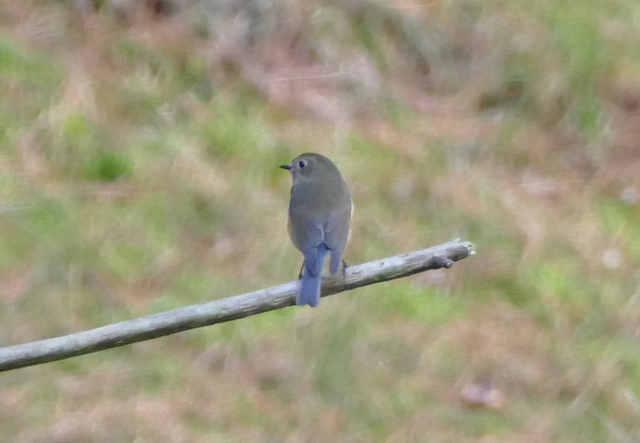 Red-flanked Bluetail – showing off its blue tail
Red-flanked Bluetail – showing off its blue tail
With reports that at least one Pallas’s Warbler was showing well again back where we had been earlier, we decided to go back for a second look. It now appeared there might be at least three along the path there. The other birders we met coming towards us on the way reported that they hadn’t been seen for a while, and sure enough the one we had seen earlier had disappeared into the trees as we passed the spot. But a little further on, we found a couple of people watching not one but two Pallas’s Warblers!
We eventually got everyone onto them – they were moving quite quickly through the trees again, so were hard to follow at times. Finally they stopped for a minute or so to feed in a low oak, and we could see them really well – crown stripe, square yellow rump patch and all. Cracking birds, Pallas’s Warblers, and that made three for us in the morning! A Swallow hawking over the pines would have been more of a surprise, had we not also seen two late ones yesterday.
Having seen all the main target birds in this area of the woods, and with it approaching lunchtime, we made our way back east towards the car. We were told that the Bluetail had returned to the drinking pool, but a quick diversion round that way and we found it had disappeared into the pines once again.
There has been a Blyth’s Reed Warbler skulking in the brambles at the eastern end of the woods for the last five days but it has been very mobile and extremely elusive. They can be difficult to see at the best of times, but given the amount of thick undergrowth here, such a skulking bird can be nigh on impossible to pin down. However, there was some interest in the group in looking for it, so we took another detour round via the area where it has been seen most often. There were lots of people milling around, but it appeared that it had not been seen or heard. We had a quick look, but eventually the call of lunch won.
After lunch, we decided to go back and have a more concerted effort to see the Blyth’s Reed Warbler. Still it had not been seen or heard from since the morning. We walked round all the likely areas, but there seemed little chance that we might stumble across it. In the end, we gave up and went to explore the area around the Dell. We had just emerged back onto the main path when we got a message to say that the Blyth’s Reed Warbler had just been seen. We hot-footed it back, but once again we found it had disappeared again as quickly as it had appeared. The trail had gone cold. Various reports from around the general area had us chasing shadows for a while, until once again we decided to give up.
We had a walk down the path beside the caravan park and out into the fields. A Great Grey Shrike had been in the bushes here earlier in the morning, and afternoon is a classic time to see this species out hunting, but we couldn’t find that either. We decided to head back to the car. It so happened that the area the Blyth’s Reed Warbler frequents was pretty much on our way back, and as we walked through the trees we came across a large crowd. They were watching the Blyth’s Reed Warbler, or at least the undergrowth where it was hiding.
After a few moments it hopped up and perched in full view on a curved wild rose stem. Half the group managed to get onto it, before it disappeared again into the vegetation. We stood for a while with the dawning realisation that it had moved on again – it was clearly very mobile and covering a large area. A whistle saw the crowd move further through the wood to where it had just been seen again. We spent some time chasing after it through the trees like this – it was always in the deepest tangles and hard to follow. We saw it fly and heard it call a couple of times, but unfortunately, it didn’t perch up nicely again and eventually we lost it once more. Time was running out, the light was fading, the weather was closing in and it started to drizzle as we walked back to the car.
It had been hard work, but what a selection of birds we had seen – waifs and strays from the east, all real rarities in this country. A Hume’s Warbler, three Pallas’s Warblers, our second Red-flanked Bluetail and a Blyth’s Reed Warbler. Wow!
















